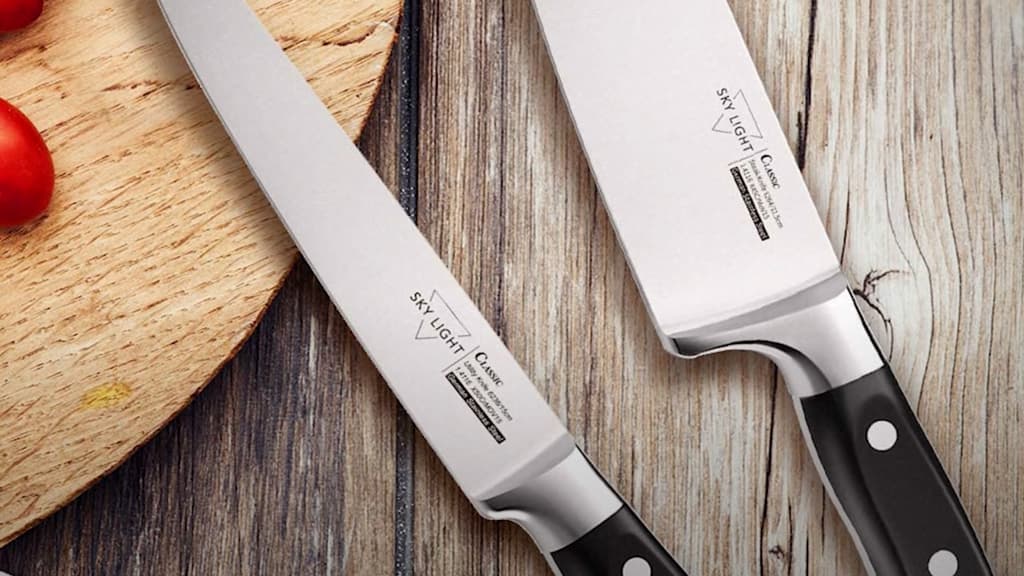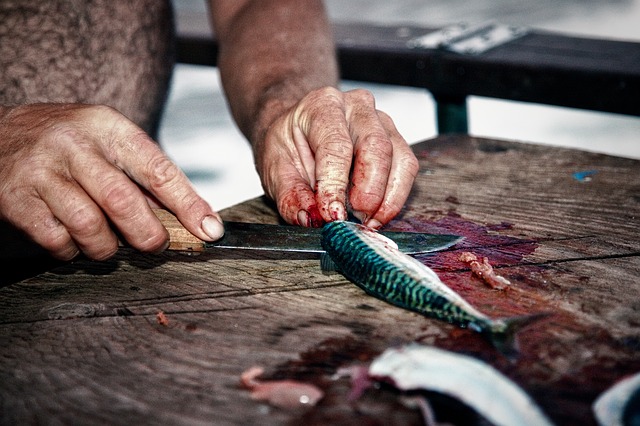A knife bolster is the thick junction between the handle and the blade of a knife, serving as a transition point which adds balance and strength.
Often found in forged knives rather than stamped ones, the bolster can be an integral part of the knife’s construction, providing a counterbalance to the blade and ensuring stability during use. The bolster has many uses that add character to a knife, but not everyone favors it.
In this article, we’ll explain everything about kitchen knife bolsters, take a look at the varieties, and compare them across Japanese and western knives. Read through the rest and find out if your next kitchen knife should come with one bolster or not.
Table of contents
What exactly is the kitchen knife bolster?
The bolster serves as a connector between the handle and the knife blade. It’s the piece of metal that starts from the end of the handle and joins the start of the blade.
Not all knives come with a bolster. Some people prefer having it; some don’t. The bolster is also seen as a piece that adds toughness to the knife, but it’s somewhat a debatable topic.
A bolster integrated into a kitchen knife can be a sign of quality because it indicates that the blade was forged from a single piece of steel. However, stamped knives can have bolsters too. Today’s manufacturing is becoming better and better every passing day. There are other ways to look for quality in a kitchen knife. See our article on how to choose a chef’s knife like a pro.
Should I choose a knife with a bolster?

The bolster adds weight to the knife – whether full or semi. It shifts the balance towards the handle. This balance between knives with and without bolsters isn’t favorable among some, especially among Japanese chefs, as it’s complimentary for them to have the balance towards the blade.
The downside to a knife with a bolster is that it requires more wrist strength to cut If the balance were towards the blade, the weight of it would aid in cutting. Since you’ll need to press harder, you can notice some strain on your wrist due to the knife’s weight when working for prolonged periods.
Handpicked for you
True cutting power in the palm of your hand
Also, the bolster creates a clearer separation between the handle and the blade. This attribute allows the bolster to protect your fingers by preventing them from slipping under the blade. Though this is good, it’s not a must-have to for your fingers. There are many ways to hold a knife where your fingers are out of danger altogether.
Handling of knives with bolster
Because the bolster is between the blade and the handle, you won’t be able to handle the knife in certain grips like the pinch grip. Because this is a very popular way to hold a knife, it’s a red flag for some. The problems like this explain why the bolster gets so much hate.
It’s a rather different scenario with inexperienced cooks. If you’re going to get a chef’s knife for the first time, you might prefer the safety the bolster provides.
Take butchering meat or fileting a fish as an example. Your hands will inevitably get slippery when working with such foods. The bolster can give you a sense of confidence and protection if you’re not comfortable enough.
Get a knife with bolster if you:
- want protection for your fingers and prefer an evenly balanced knife.
- like the cutting angle the bolster creates.
- don’t mind the slightly harder sharpening process.
Don’t get a knife with bolster if you:
- want to sharpen the blade quickly.
- prefer the balance towards the blade. (applies to knives with light handles)
- grip the spine of the blade while cutting.
Types of bolsters on kitchen knives
If you’re choosing a knife with a bolster, you will need to pick either one of the two primary types, each having its own advantages and disadvantages.
Full bolsters

The full bolster in kitchen knives extends to the bottom of the blade. This continuation creates what’s known as the finger guard. It gives better protection for fingers by acting as a stoppage, preventing them from going underneath the blade.
The finger guard also occurs naturally in some cases as a result of forging but often doesn’t reach the heel of the blade. So, the full bolster is not necessary to have a finger guard.
This type of bolster creates a different cutting angle due to the handling of the knife as it’s heavier. Suppose you use a knife with a full bolster and a half bolster – the other type of bolster – and perform the same task. You will notice that both have distinctive feels as the cutting angles are not the same.
Advantages and disadvantages of full bolster
Here is a summary of the pros and cons of knives with a full bolster.
Pros
- Hand protection: The ample bolster ensures your fingers are protected from sliding onto the blade.
- Accessibility: It’s easier and safer for beginners to get into.
Cons
- Sharpening difficulty: Harder to sharpen and doesn’t work with some sharpeners due to the more extensive bolster.
- Heft: The added material might make the knife heavier, which could be a disadvantage if you prefer a lighter tool for agile tasks.
- Hinders knife movement: Limited in some aspects as you can’t use certain grips.
Half bolsters
As the name suggests, half bolsters knives aren’t as prevalent as the full bolsters. It doesn’t extend all the way from the bottom of the blade, creating a smoother transition between the handle and the blade.

The design of the semi bolster eases the sharpening process of the blade. If you’re planning on sharpening the blade yourself and using simple tools to sharpen up your kitchen knife, a knife with a semi bolster will be the better and easier option.
On the contrary, half bolsters generally don’t have a finger guard, and it’s easy to think that this makes them susceptible to safety issues. As long as the knife is in good hands, or trained and experienced hands, in other words, there won’t be a need for a finger guard.
Additionally, make sure the knife you’re using is always sharp. A dull knife is a lot more dangerous than a sharper one that will cut through anything that gets in its way.
Advantages and disadvantages of half bolster
Here is a summary of the pros and cons of knives with semi bolster.
Pros
- A somewhat more dynamic grip.
- Comfortably making delicate cuts with precision.
- Easy sharpening.
Cons
- Doesn’t have that extra protection (only a setback depending on the person)
Full bolster vs. half bolster vs. no bolster
The full bolster moves the balance of the knife toward the handle. A knife with this type of balance requires more pushing strength. You will need to use more force to cut, as opposed to a knife with a balance toward the blade.
On the other hand, half bolsters provide more freedom, as you can handle the blade in different ways that you can’t with a full bolster. Knives with half bolsters are also lighter due to having a smaller profile.
No bolster amplifies the advantages and disadvantages of a half bolster. The knife becomes extra lighter and easier to control but eliminates the finger guard completely.
Overall, the choice mainly depends on the likings of the user. It’s all a matter of preference, not that either type of bolster is superior to the other.
Bolster in Japanese kitchen knives vs western knives

You can have a French or German kitchen knife with either a full or half bolster or no bolster at all. It’s a different story with Japanese knives, especially if they have a wa-handle, the traditional Japanese handle.
Most Japanese knives with a traditional handle don’t have a bolster, and the ones that do are different from western chef’s knives.
Use of bolster in Japanese knives
The Japanese knife handles are mostly made from wood. When the blade and the handle come together, there is a risk of cracking. To overcome this issue, bolsters made from buffalo horn are placed over the end of the handle.
Though this method was mainly used in the past, there are now ways both can be fused together without causing damage. Nevertheless, the bolster is still there as a design element in some Japanese knives.
Also, Japanese like their knives lighter, and metal is rarely used as a bolster as it would add excess weight. The buffalo horn is still used in the making of bolsters in Japanese knives to this day.
If you’re looking for a Japanese knife with a bolster similar to western knives, you will need to look for one with a yo-handle. This type of handle in Japanese knives is basically the same as western chef’s knives.
Conclusion
The bottom line is that every cook is different, and so are their preferences. It all boils down to your needs, cutting style, and comfortability with a kitchen knife.
If you want to get better at your technique and experiment with different ways of cutting, a knife without bolster will be a better pick. Whether the knife you desire has a bolster or not, we’ve got you covered. Head to our products page and see what we have to offer.












